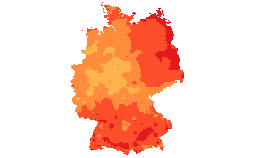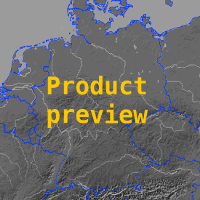Keyword
Climatology, meteorology, atmosphere
14 record(s)
Provided by
Type of resources
Available actions
Topics
Keywords
Contact for the resource
Update frequencies
-
wind speed measurements at DWD stations in the Regional Basic Synoptic Network of the WMO, plus additional stations from the so called "Global Dataset" of DWD
-
precipitation measurements at DWD stations in the Regional Basic Synoptic Network of the WMO, plus additional stations from the so called "Global Dataset" of DWD
-

2m temperature measurements at DWD stations in the Regional Basic Synoptic Network of the WMO, plus additional stations from the so called "Global Dataset" of DWD
-
relative humidity measurements at DWD stations in the Regional Basic Synoptic Network of the WMO, plus additional stations from the so called "Global Dataset" of DWD
-

-
calculated values for potential Evaporation over gras at DWD stations in the Regional Basic Synoptic Network of the WMO, plus additional stations from the so called "Global Dataset" of DWD
-
Karten zu mittlerer, minimaler und maximaler Temperatur (2m), Niederschlag, Sonnenscheindauer für Deutschland; jeweils Jahres- und Monatsreferenz als langjähriger Mittelwert (1961-1990) abgeleitet aus Messungen der Stationen des Deutschen Wetterdienstes. Der GeoServer des DWD stellt Jahresreferenzkarten bereit. Diese sind unter folgenden Bezeichnungen zu finden: TAMM_17_1961_30 (Durchschnittstemperatur), TADNMM_17_1961_30 (mittlere Minimaltemperatur), TADXMM_17_1961_30 (mittlere Maximaltemperatur), SDMS_17_1961_30 (Sonnenscheindauer), RSMS_17_1961_30 (Niederschlag). Monatbezogene Rasterdaten und weitere Parameter stehen zum Download auf dem CDC-FTP-Server bereit. Generelle Informationen zum Datenangebot des CDC, sowie Erläuterungen zu den Nutzungsrechten sind zu finden unter: ftp://ftp-cdc.dwd.de/pub/CDC .
-

Grids are derived from DWD stations and legally and equivalent partner stations in Germany.
-

Grids are derived from DWD stations and legally and qualitatively equivalent partner stations in Germany.
-

The TROPOMI instrument onboard the Copernicus SENTINEL-5 Precursor satellite is a nadir-viewing, imaging spectrometer that provides global measurements of atmospheric properties and constituents on a daily basis. It is contributing to monitoring air quality and climate, providing critical information to services and decision makers. The instrument uses passive remote sensing techniques by measuring the top of atmosphere solar radiation reflected by and radiated from the earth and its atmosphere. The four spectrometers of TROPOMI cover the ultraviolet (UV), visible (VIS), Near Infra-Red (NIR) and Short Wavelength Infra-Red (SWIR) domains of the electromagnetic spectrum. The operational trace gas products generated at DLR on behave ESA are: Ozone (O3), Nitrogen Dioxide (NO2), Sulfur Dioxide (SO2), Formaldehyde (HCHO), Carbon Monoxide (CO) and Methane (CH4), together with clouds and aerosol properties. This product displays the Nitrogen Dioxide (NO2) near surface concentration for Germany and neighboring countries as derived from the POLYPHEMUS/DLR air quality model. Surface NO2 is mainly generated by anthropogenic sources, e.g. transport and industry. POLYPHEMUS/DLR is a state-of-the-art air quality model taking into consideration - meteorological conditions, - photochemistry, - anthropogenic and natural (biogenic) emissions, - TROPOMI NO2 observations for data assimilation. This Level 4 air quality product (surface NO2 at 15:00 UTC) is based on innovative algorithms, processors, data assimilation schemes and operational processing and dissemination chain developed in the framework of the INPULS project. The DLR project INPULS develops (a) innovative retrieval algorithms and processors for the generation of value-added products from the atmospheric Copernicus missions Sentinel-5 Precursor, Sentinel-4, and Sentinel-5, (b) cloud-based (re)processing systems, (c) improved data discovery and access technologies as well as server-side analytics for the users, and (d) data visualization services.
 INSPIRE-1
INSPIRE-1